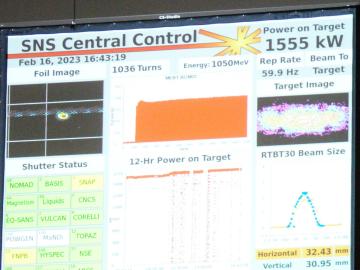
Filter News
Area of Research
- (-) Biological Systems (15)
- (-) Computer Science (7)
- (-) Neutron Science (90)
- Advanced Manufacturing (15)
- Biology and Environment (86)
- Biology and Soft Matter (1)
- Building Technologies (4)
- Chemistry and Physics at Interfaces (5)
- Clean Energy (268)
- Climate and Environmental Systems (3)
- Computational Biology (4)
- Computational Engineering (2)
- Data (1)
- Electricity and Smart Grid (1)
- Energy Frontier Research Centers (8)
- Energy Sciences (3)
- Fossil Energy (2)
- Fuel Cycle Science and Technology (1)
- Functional Materials for Energy (9)
- Fusion and Fission (26)
- Fusion Energy (2)
- Geographic Information Science and Technology (2)
- Isotope Development and Production (2)
- Isotopes (19)
- Materials (260)
- Materials Characterization (2)
- Materials for Computing (13)
- Materials Synthesis from Atoms to Systems (6)
- Materials Under Extremes (6)
- National Security (41)
- Nuclear Science and Technology (32)
- Nuclear Systems Modeling, Simulation and Validation (1)
- Nuclear Systems Technology (1)
- Quantum Condensed Matter (1)
- Quantum information Science (2)
- Reactor Technology (1)
- Renewable Energy (1)
- Sensors and Controls (2)
- Supercomputing (125)
- Transportation Systems (5)
News Type
News Topics
- 3-D Printing/Advanced Manufacturing (3)
- Advanced Reactors (1)
- Artificial Intelligence (3)
- Big Data (2)
- Bioenergy (3)
- Biology (4)
- Biomedical (4)
- Biotechnology (1)
- Climate Change (1)
- Composites (1)
- Computer Science (9)
- Coronavirus (5)
- Cybersecurity (2)
- Decarbonization (1)
- Energy Storage (3)
- Environment (4)
- Exascale Computing (1)
- Frontier (1)
- Fusion (1)
- High-Performance Computing (2)
- Materials (6)
- Materials Science (14)
- Microscopy (1)
- Nanotechnology (7)
- National Security (1)
- Neutron Science (48)
- Nuclear Energy (1)
- Physics (7)
- Quantum Science (6)
- Security (1)
- Space Exploration (1)
- Summit (5)
- Sustainable Energy (2)
- Transportation (3)
Media Contacts

A team of scientists led by the Department of Energy’s Oak Ridge National Laboratory designed a molecule that disrupts the infection mechanism of the SARS-CoV-2 coronavirus and could be used to develop new treatments for COVID-19 and other viral diseases.

ORNL has entered a strategic research partnership with the United Kingdom Atomic Energy Authority, or UKAEA, to investigate how different types of materials behave under the influence of high-energy neutron sources. The $4 million project is part of UKAEA's roadmap program, which aims to produce electricity from fusion.

ORNL's Spallation Neutron Source set a world record when its linear accelerator reached an operating power of 1.55 megawatts, which improves on the facility’s original design capability.

ORNL staff members played prominent roles in reports that won one Distinction award and two Excellence awards in the 2022 Alliance Competition of the Society for Technical Communication. PSD's Karren More and Bruce Moyer participated.

The truth is neutron scattering is not important, according to Steve Nagler. The knowledge gained from using it is what’s important

Paul Langan will join ORNL in the spring as associate laboratory director for the Biological and Environmental Systems Science Directorate.

While studying how bio-inspired materials might inform the design of next-generation computers, scientists at ORNL achieved a first-of-its-kind result that could have big implications for both edge computing and human health.

Researchers at ORNL have developed a new method for producing a key component of lithium-ion batteries. The result is a more affordable battery from a faster, less wasteful process that uses less toxic material.

Researchers at ORNL and the University of Tennessee, Knoxville, discovered a key material needed for fast-charging lithium-ion batteries. The commercially relevant approach opens a potential pathway to improve charging speeds for electric vehicles.

Scientists at ORNL used neutron scattering to determine whether a specific material’s atomic structure could host a novel state of matter called a spiral spin liquid.


